Italy
Doctrinaries in the world
The Doctrinaries in Italy: a short history… of five centuries
On June 28, 1664, the Doctrinaries of the Province of Avignon, in France, opened a college with schools of grammar, rhetoric and philosophy in Sospello, a mountain village in the diocese of Ventimiglia. Thus the Congregation expanded into Italy and in 1683 they opened two houses in Ivrea.
In 1701 it was the turn of a small college in Ferentillo, near Terni, followed by the opening of other colleges in Ronciglione (Viterbo) and San Marino, and the seminaries of Spoleto and Bevagna in Umbria.
In 1706, the Municipality of Civitavecchia invited the Doctrinarians Fathers to settle in the city, while in 1710, at the request of Prince Pamphili, the Congregation took over the direction of the seminary of Sant’Agnese, in Piazza Navona in Rome. The seminary and the parish of San Nicola degli Incoronati are the first activities in the Eternal City.
In 1726 Benedict XIII entrusts the Doctrinarians with the church of Santa Maria in Monticelli, in the heart of Rome. In fact, the Pope knows that in the “Regola” neighborhood, where the church is located, there are people who need moral and religious instruction. Thus was born the fourth Province of the Congregation, called Roman, formed by all the houses in the Italian States of that time: the Kingdom of Savoy, that of Naples and the Papal States. In 1725 Benedict XIII, in order to foster the development of the institutions of Christian Doctrine, on his own initiative and authority, with the consent of those concerned, united the Congregation of Naples with that of Avignon. The Pope detached from the Province of Avignon all the colleges located on this side of the Alps: the houses of Ferentino (Vt), Ronciglione (Vt), Civitavecchia (Rm), San Martino, Sospello (today in France), Ivrea (To), the seminaries of Bevagna and Spoleto in Umbria and, in 1726, the house of Santa Maria in Monticelli in Rome and unites them with the houses of the Congregation of Naples that were located in Laurito (Sa), Laureana (Sa), Sorbo (Av), San Giovanni in Galdo (Cb) and Caserta, thus forming the Roman Province. The Pope established that Father César had to be recognized as the sole founder of the Congregation, called the “Secular Clerics of the Christian Doctrine of Avignon”.
In 1747 the Congregation grew with the houses of Sant’Agata in Trastevere in Rome, Velletri (Rm), Palestrina (Rm), Orvieto (Tr), Segni (Rm), Rocca Massima (Lt) and Ariccia (Rm).
The arrival in Pontecorvo
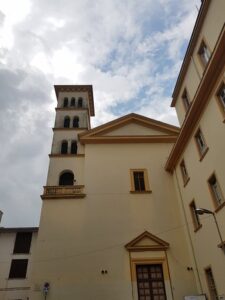
The church of San Marco
On the evening of June 22, 1739, two fathers and a brother left the house of Santa Maria in Monticelli in Rome, destined for Pontecorvo (Fr). The bishop of Aquino and Pontecorvo, Monsignor Giuseppe De Carolis, after having asked for information from the bishop of Spoleto, in whose diocese the Doctrinaries had the direction of two seminaries, decided to entrust the episcopal seminary to the Fathers. Soon, they accepted the proposal to open a public school and, for this reason, the community was enriched by two more fathers and a brother.
In 1740 they introduced the devotion to Maria Santissima Addolorata and erected the relative Confraternity that the bishop approved four months later. In 1745 they were also entrusted with the parish of San Marco, to which the nearby parish of San Michele Arcangelo was united. The Fathers undertook to build a new church and a college. The new church is completed in 1785, and in it is dedicated an altar to Maria Santissima Addolorata in whose honor is celebrated every Friday and, solemnly, the septenary every year in September, with a procession. Bishop Lucibello, after visiting the community in 1819, wrote to the Provincial Superior of the Doctrinarians: «I am edified by the conduct of these excellent ecclesiastics. They form the finest part of this clergy of mine». In the church of San Marco, St. Leonard of Porto Maurizio is invited to preach and, in 1849, Pius IX is welcomed with great joy by the Doctrinarians. During the Second World War, bombings destroyed the church and the college. The Fathers decided to remain in the midst of the people, exposed to the danger of collapses, the pitfalls of wind, rain and malaria, bringing comfort to the survivors. Father Cesare Centanni, parish priest, and Fathers Quattrino, Conte and Centi, immediately began to clear the rubble and start the reconstruction of the church, the college and the parish house.
The bombings will rediscover a stone on which is written “PPPPP 1754”, that is “Primi Patres Primam Petram Posuerunt. 1754”, as well as another stone on which is written “PP.DC. 1754”, that is “Patres Doctrinae Christianae 1754”.
Arrival in San Damiano d’Asti
The Jacobin laws, the confiscation of religious property by the State and religious suppression led the surviving Fathers of the Piedmontese Province to use their last savings to buy a house in San Damiano d’Asti. In this house, owned by the Nuvoli Counts, in 1870 the meeting between Don Giovanni Bosco and the future Cardinal Gamba took place, whom the Saint had welcomed as a boy in his oratory in Valdocco.
In 1885, Father Giuseppe Giacobbe was appointed vice-rector of this new college, which became the starting point for a flourishing of vocations not only for the benefit of the Piedmont Province but for the entire Congregation. A church dedicated to the Virgin of Sorrows, the main patron saint of the Congregation, was also built in San Damiano, where an altar to Saint Michael was placed inside to keep alive the memory of the foundation of the Congregation. Next to the church, the building was renovated to serve as a novitiate house.
Craviano, a hamlet of Govone, Asti
In 1895, the Fathers purchased a convent of the Capuchin Friars in Craviano and Father Giacobbe worked hard to ensure that the house became the seat of the postulancy of the Province.
Early 20th Century. From San Damiano to Turin
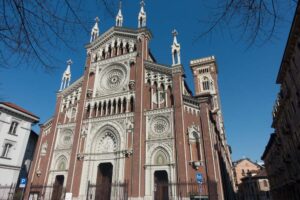
Parish of Jesus Nazarene. Turin
Father Giacobbe thinks that, to better take care of intellectual formation, it is desirable to have a house in Turin…and Providence also helps him in this work.
A few years earlier an extraordinary event had occurred in the church of Santa Maria in Monticelli in Rome: a painting depicting Jesus of Nazareth had repeatedly opened its eyes. This had occurred in 1854. The painting had been transferred to the high altar of the church for solemn celebrations. After a regular process at the Vicariate of Rome, on 17 October 1854, Cardinal Costantino Patrizi, Vicar of Rome, had issued the following Decree: “We have decreed and we decree and judge that the movement of the eyes in the aforementioned image of Jesus of Nazareth venerated in the church of Santa Maria in Monticelli is true, a proven movement that should be counted among the prodigious works of Almighty God and therefore above the order of nature; and therefore for the greater glory of God and for the greater increase of devotion to the Most Holy Redeemer, Our Lord Jesus Christ, we grant permission to publish the report of this religious fact and to make it known.”
This is why Father Tommaso Lanza, Superior General of the Congregation, suggested to Father Giacobbe that the church being built in Turin be named after Jesus of Nazareth…and so it happened. On November 24, 1904, the solemn laying of the first stone took place and, a year later, Father Giacobbe was appointed parish priest of the new parish, the only one in Italy with the name Jesus of Nazareth. During the Second World War, the fathers’ home and the parish church were repeatedly hit by incendiary bombs during air raids. The bombs tore off doors and windows, damaged walls and the ceiling, but the church remained standing.
In the 1930s the arrival in Varallo Sesia
In the 1930s the Fathers began their presence in Val Sesia. In 1928, Father Francesco Raspino, invited by Podestà De Marchi, accepted, alongside Canon Belletti, the management of the Civico Collegio D’Adda. The gymnasium had been closed due to a lack of students and the college had followed the same fate. With great faith, Father Raspino reopened the gymnasium and the college, which gradually repopulated. In 1935 Father Raspino asked for the direct collaboration of the Doctrinaries. Two years later the Gymnasium was given equal status, a state recognition that was quite rare at the time, and in 1937 the Doctrinaries officially entered Varallo Sesia, with the signing of the contract for the management of the college. The Fathers immediately began an educational project that involved the whole of Val Sesia: they established middle schools and high schools and obtained legal recognition for them; from 1947 they opened other schools in Borgosesia. The middle schools and the two high schools, the classical one in Varallo and the scientific one in Borgosesia, in their origins and development, remain a testimony to the active faith of the Doctrinaries, with the active collaboration of the civil authority.
In addition to these schools, in 1948, at the invitation of the Municipality, the college established the Commercial Technical School, which in 1953 was transformed into a State Technical School and is the basis of the Professional Hotel Institute. The prospect of a long stay in Varallo allowed the Fathers to use the land in the Orelli area, donated by Father Raspino, as a seminary, where generations of Doctrinaries were trained. Two Fathers, in particular, spent a lot of energy in these works: Felice Morero, who for his action in support of the Resistance, was reported to the fascist occupation troops and subjected to mistreatment, and Father Enrico Allovio who, at a time when the press was forced by the regime to remain silent or to engage in servile flattery, enduring incredible intimidation, persecution and threats, always kept the light of truth alight from the columns of the Catholic newspaper of Valsesia, to illuminate the path to freedom. But other Fathers also remain and are points of reference for generations of young people, it is enough to mention Fathers Mazzucco, Gallino, Tonin, Zacquini.
In Salerno, the Church of the Holy Family designed by Portoghesi and the Edizioni Dottrinari
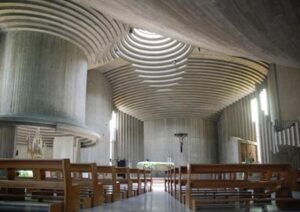
The Santa Famiglia Church
On May 20, 1935, the Vicar General of the Archdiocese of Salerno, Don Antonio Balducci, on behalf of Archbishop Nicola Monterisi, wrote to the Superior of the Doctrinaries and invited him to “open a religious house in this city, and precisely in the Fratte district… Monsignor Archbishop would offer the religious a small convent in good condition and large enough to accommodate several religious, with the annexed church which is currently also a canonical parish.”
On August 5, 1935, the Archbishop signed the deed of transfer of the “Church of the Holy Family in Fratte di Salerno with its appurtenances and annexed convent with the burden of a monthly Mass, the proper instrument of foundation of the church, placed by the donor of the land on which the church was built… the parish priest will be appointed by the Archbishop upon designation of the Most Reverend General Provost”. The Superior General Giuseppe Rori signed for the Doctrinaries.
From the first day of their presence in the parish, the Fathers worked with enthusiasm and dedication to the spiritual growth of the faithful, with particular attention to children and young people, through the teaching of catechism and the many initiatives and activities of a religious, social and educational nature, as evidenced by the winning, for several years, of the diocesan pennant, at the end of the catechism year. The Second World War brought destruction and victims: the house and the parish church of Salerno were bombed several times during the days of battle, but the most serious damage was caused by the mines that blew up the bridge adjacent to the house.
In the parish of Salerno, on December 11, 1950, the parish nursery school was opened in the parish hall to accommodate children from four years of age and up, led by a teacher and assistants with canteen, thanks to the contribution of a minimum fee from some wealthier families, an extraordinary annual subsidy from the Ministry of Public Education and, above all, the generosity of the population. It remained in the parish premises until the end of October 1957, when it moved to the new location in via Calata San Vito, built over the course of four years, between interruptions and restarts of the work. At the beginning of the 1960s, the parish cinema opened in the premises on the ground floor of the nursery school in via Calata San Vito, which was frequented by many families.
In 1964, in Salerno, the Edizioni Dottrinari were also born. The soul and pioneer of this catechistic apostolate was Father Alessandro Iadecola. The work began in the rooms of the old church, with the printing, by mimeograph, of the weekly paper La Domenica, which contained a chronicle of parish life. After purchasing the first machinery, the printing activity continued with printed materials and teaching aids for catechism, whose modest cost and practicality contributed to orienting many parish priests towards the Doctrinaries Fathers, who found in the publications a valid aid for parish catechism. The result is that “the name of the Congregation in the region is no longer unknown” – writes Father Roberti – “priests and lay people know our activity, the bishops of the area praise and bless the work”.
The publishing initiatives multiply: in addition to books, pamphlets, active notebooks, biblical vigils, images and other printed materials, the monthly magazine for students Vele al vento is born; a wall calendar is printed with views of the land of Jesus, sent to all the bishops, curias and catechetical offices of Italy, as well as to the Holy Father, who sends his blessing; a school diary is printed, unique in its kind, with photos of the province of Salerno, with the applause of the Minister of Tourism and other bodies; finally, the magazine Modelli e Sport, distributed on a national scale is sent for exchanges with other magazines and by subscription to many countries of the world.
Since 1988, Edizioni Dottrinari has moved to its new headquarters in Pellezzano, and continues to be a publishing reality at the service of pastoral care and catechism. The direction was entrusted to Father Francesco Gatto and then to Father Franco Mangili. This is what Monsignor Gerardo Pierro, Archbishop of Salerno, said in 2005, during the Concelebration for the celebrations of the seventieth anniversary of the presence of the Doctrinaries in the Diocese, of fortieth anniversary of the birth of Edizioni Dottrinari and of thirty years since the inauguration of the new church in Fratte: «Many of our parishes have been able to enjoy the fruits of their commitment, of this catechetical mediation, which they did at the beginning, when the first catechisms of the CEI came out and not everyone felt at ease. The mediation that Father Alessandro, through his publications, carried out, served our communities and for this too I, on behalf of the entire diocese, want to say heartily: thank you!». In addition to the editorial work, in 2013 the Fathers expanded their presence spaces in Pellezzano and opened a shop for the distribution of books and religious articles.
Another important work carried out in Salerno is the construction of the new church of the Holy Family, in the early 1970s. The project was entrusted to the engineer Vittorio Gigliotti, associated with the studio of the architect Paolo Portoghesi. On December 8, 1971, the archbishop of Salerno Gaetano Pollio blessed the first stone of the new church tenaciously desired by Father Nicola Roberti, who opened it for worship on June 1, 1974, even without the floor, built in 1984.
The college of Saluzzo
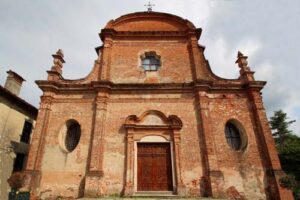
Church of San Bernardo. Saluzzo
In 1936, the Civic College of Saluzzo was entrusted to the Doctrinaries, at the invitation of the Marquis Carlo del Carretto, Podestà, and the Bishop of Saluzzo, Monsignor Oberti, who also entrusted the Fathers with the annexed church of San Bernardo. The purpose of the college was to assist young people, to offer them a family environment and to accustom them to studying in order to introduce them to middle, high, technical, teacher training and commercial schools. Young people flocked to the college from the countryside, from the city centers and from Turin itself. Under the direction of the Doctrinaries, among whom we remember Fathers Raspino, Allovio, Battaglino, Morero, Francone, Amerio, Rolando, Sticca, Squillari and Tonin, an educational, Christian and intellectual mission began.
The Parish in Rome, at the Tomb of Nero
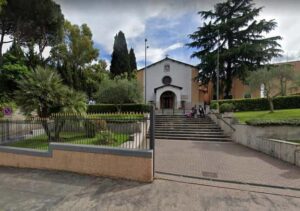 In 1939 the Vicariate of Rome proposed to the Doctrinaries the spiritual care of the village called Tomba di Nerone, then not yet a parish but a vice-curate. The proposal was accepted, the religious community was formed by Father Giovanni Delpero, assistant bursar, Father Carmine Conte and the brothers Raffaele Piccolo and Carlo Rey. Father Orlando Visconti arrived a few months later as vice-parish priest. In 1940, construction work began on the church and parish house. The inauguration took place on 11 October 1941. The Osservatore Romano of the following 17 October reported the event as follows: «S.E. Mons. Francesco Pascucci blesses the new parish church of Sant’Andrea apostolo, received at the entrance of the temple by the local civil authorities and the Doctrinaries Fathers with their Superior General Father Giuseppe Rori. After the speech of the Most Excellent Celebrant, the Eucharistic procession took place from the church of the Ursuline Sisters of Gandino to the new temple and was followed by the blessing of the Most Holy Sacrament. The new church is built in a rustic style appropriate to the character of the village, composed mainly of farmhouses and seminal farms in the wide expanse of the countryside.
In 1939 the Vicariate of Rome proposed to the Doctrinaries the spiritual care of the village called Tomba di Nerone, then not yet a parish but a vice-curate. The proposal was accepted, the religious community was formed by Father Giovanni Delpero, assistant bursar, Father Carmine Conte and the brothers Raffaele Piccolo and Carlo Rey. Father Orlando Visconti arrived a few months later as vice-parish priest. In 1940, construction work began on the church and parish house. The inauguration took place on 11 October 1941. The Osservatore Romano of the following 17 October reported the event as follows: «S.E. Mons. Francesco Pascucci blesses the new parish church of Sant’Andrea apostolo, received at the entrance of the temple by the local civil authorities and the Doctrinaries Fathers with their Superior General Father Giuseppe Rori. After the speech of the Most Excellent Celebrant, the Eucharistic procession took place from the church of the Ursuline Sisters of Gandino to the new temple and was followed by the blessing of the Most Holy Sacrament. The new church is built in a rustic style appropriate to the character of the village, composed mainly of farmhouses and seminal farms in the wide expanse of the countryside.
The first parish priest was appointed on February 17, 1944 and was Father Agnello Simonelli. The Second World War, in addition to causing the departure of some Doctrinaries for the front, brought much damage to the houses. The parish church of Sant’Andrea was hit by several cannon shots.
Vigevano, the Negrone College and the Parish of Christ the King
On August 12, 1954, the Doctrinaries entered the college of the Pio Istituto Negrone in Vigevano (PV), called by Bishop Luigi Barbero to “take care of the religious, civil and technical formation of the youth, orienting themselves towards the footwear sector”. In June 1959, to offer the boys activities also during the summer, a large swimming pool was built next to the playing fields, which in forty years would collect 15 thousand visitors.
In the same city, in 1962, on the feast of Christ the King, the presence of the Fathers also began in the parish of the same name.
Starting in 1963, the right wing of the Negrone was converted to house sections of the new Besozzi state middle school, 9 classes with over 270 students, while the left wing hosted the Regina Margherita elementary school (250 students). In the 1970s, the semi-boarding school was established with hospitality from 7:30 to 18:00, with the payment of a modest fee. The institute is open to the city: one of the 5 football fields is available to the population for tournaments and events, including regional ones.
In November 1973, the church dedicated to San Giovanni Battista was restored and the remains of the founder of the Institute, Giovanni Battista Negrone, his wife Francesca Manara, their three daughters, and Anna Maria Colli Cantone, Francesca’s mother, were transferred. In 1979, Father Battista Previtali, Provincial Superior, asked the administration of the Pio Istituto Negrone to use the premises previously occupied by the nuns to create a training house for boys and young people for vocational guidance. The activity was carried out until 1997, the young people also committed themselves by helping the Fathers in the recreational activities of the students of the Negrone. In 1980 the Summer Center began, with activities on weekdays from morning to evening, including lunch, in July and August. The Doctrinaries are supported by the Pianzoline nuns and lay people. The first year there were 150 enrolled, in the following years the experience grew by involving young people from parishes throughout the city. In 1983, the Alumni Association was born to maintain friendly relations between former students and teachers; every year, the Association organizes, on the first Sunday of April, a day between former students with their families and the Doctrinaries.
The demographic decline of the 1980s led to a decrease in enrollment and classes in the schools of Vigevano. It was then decided to open sections of a state-approved school: the role of Headmaster and the teaching of religion and literary subjects were entrusted to qualified Doctrinary Fathers, while lay teachers were appointed for the other subjects: but the growing costs for maintaining the school pushed the Doctrinaries to close the Negrone Institute on 31 July 1997.
In Sanremo the College of Villa Magnolie
In 1957, on June 28, the Solemnity of the Sacred Heart, the Superior General of the Doctrinaries went to San Remo to take over the beautiful “Villa Magnolie”, with the aim of opening a new college with a Middle School. Thus the Bishop of Ventimiglia, Monsignor Agostino Rousset, wrote to the Father General: «We gladly express our consent to the opening in San Remo of a boarding college for boys with a legally recognized Middle School, for the benefit of the student youth, by the worthy Congregation of the Fathers of Christian Doctrine, to whom we wish a prosperous spiritual future».
In Sicily, in Vittoria, Santa Maria Goretti, Madonna Assunta and Holy Spirit and Madonna delle Lacrime
In 1967, the Congregation opened a new house in Sicily, in the Diocese of Ragusa, kindly welcomed by Bishop Francesco Pennisi, by the population and by the clergy, in particular by Monsignor Carmelo Ferraro, archpriest of Vittoria, and by Monsignor Giuseppe Calì, parish priest of the Santissimo Rosario, who generously gave them an initial welcome. Fathers Carmelo La Bella and Lodovico Santoro were entrusted with the pastoral care of the Madonna delle Lacrime parish.
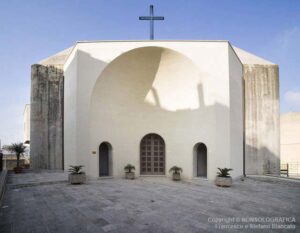
Parish Church Madonna Assunta
Subsequently, the parish of Santa Maria Goretti was entrusted to Father Santoro and the parish of Madonna Assunta to Father La Bella. Later, having left the parish of Santa Maria Goretti, Bishop Monsignor Angelo Rizzo entrusted the new parish of Spirito Santo to the Congregation.
In a spirit of service, the Fathers dedicate themselves with passion and dedication to the proclamation of the Gospel and to the priestly ministry. This is combined with a scholastic commitment to teaching and accompanying religious formation in the cultural context of the city. Various brothers carry out their service in Vittoria, among whom above all, Father Dario Liscio, Father Carmelo La Bella and Father Lodovico Santoro, to whom the Municipality has conferred honorary citizenship, for their great commitment to the citizens. During Father Dario’s service in the presence of General Rinaldo Gasparotto, the Municipal administration named a square after Blessed Cesare de Bus, Founder of the Doctrinal Fathers. Furthermore, after Father Liscio, after his sudden death, the Municipality itself wanted to name a square after him. From the catechistic work of these holy priests two doctrinal vocations were born.
On Sunday 1st September, on the liturgical feast of Our Lady of Tears, the parish of the same name in Vittoria was entrusted to the Doctrinal Fathers by the bishop of Ragusa, Monsignor Giuseppe La Placa.
Father Giuseppe Giunta has taken on the role of parish priest, in addition to that of the Madonna Assunta parish.
Grosseto and the Holy Crucifix
In 1974, the Piedmont Province opened a new work camp in Grosseto, taking on the management of the Santissimo Crocifisso parish, a semi-boarding school, a youth center and teaching in the state school. For this initiative, the Provincial Council designated Father Pasquale Amerio, superior and parish priest, Father Ugo Costa, Father Francesco Gatto and the professed Lorenzo Rossit.
The Oratory in Mazzarino
In 1978, the Doctrinaries began a new activity in Mazzarino, in the province of Caltanissetta. The Salesians, who ran an Oratory in that town, decided to close. The same Inspector of Sicily of the Sons of Don Bosco, on April 2, 1978, went to welcome the Doctrinaries Ernesto Ferrero and Gino Bertan at the Catania station. After a short breakfast, the Fathers left for Mazzarino where, at midday, they concelebrated with the bishop of the Diocese of Piazza Armerina, Monsignor Sebastiano Rosso. Then they went to visit the new house. It was a large Oratory, with rooms, porticoes and a cinema-theater with over six hundred seats. The people welcomed them with great joy and generosity and they immediately began their apostolate. Towards the end of April, Father Gian Mario Redaelli, Father Carmelo La Bella and Brother Vincenzo Arcadipane joined them.
